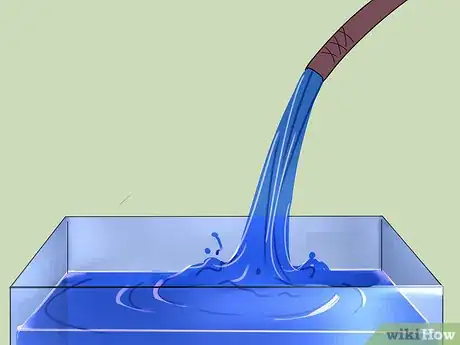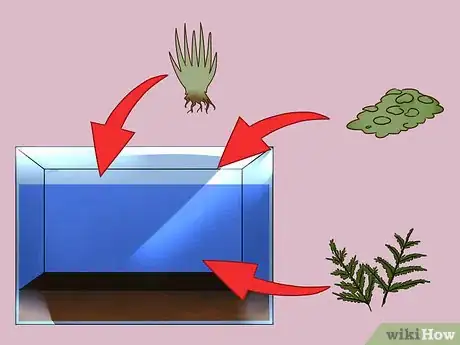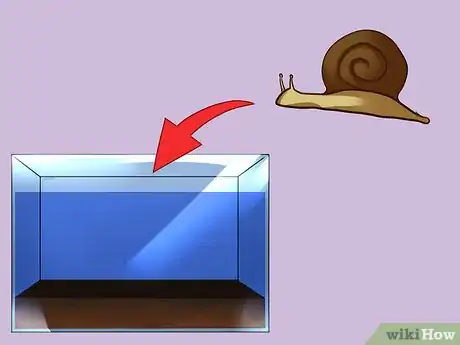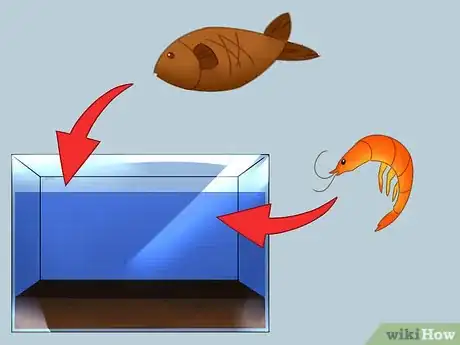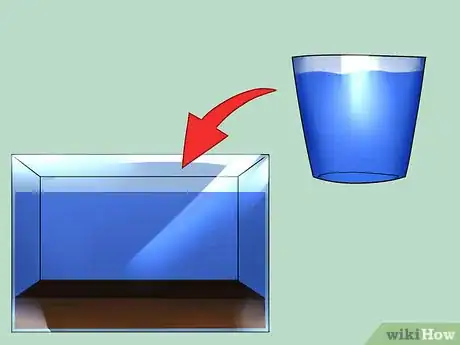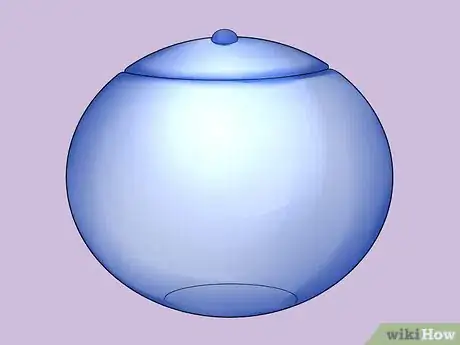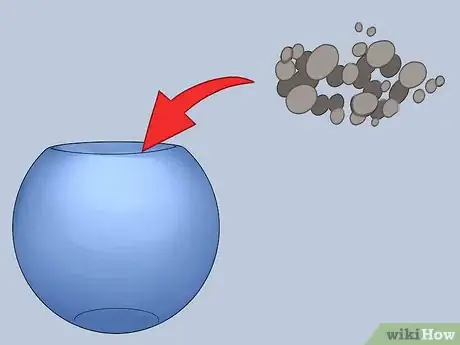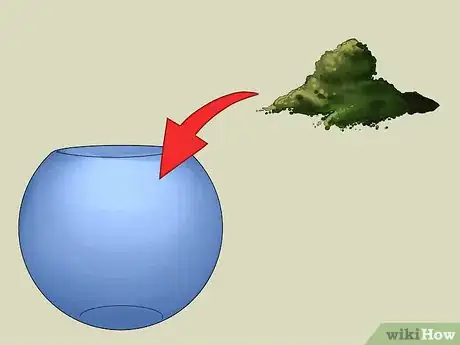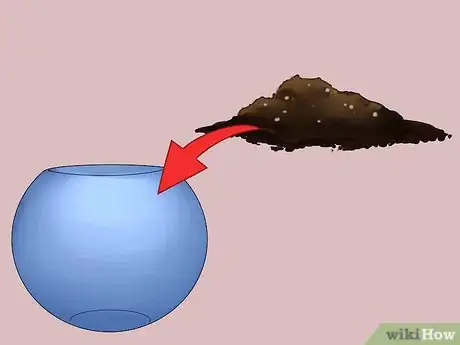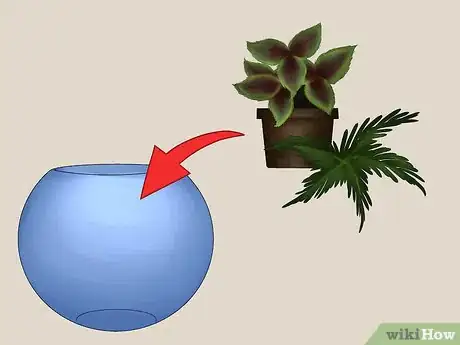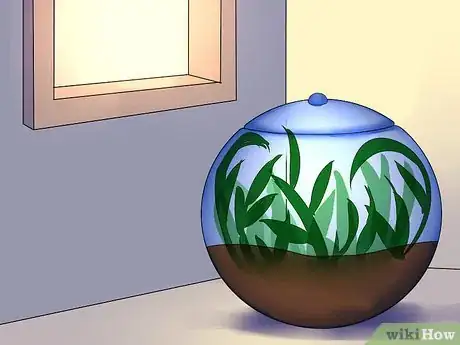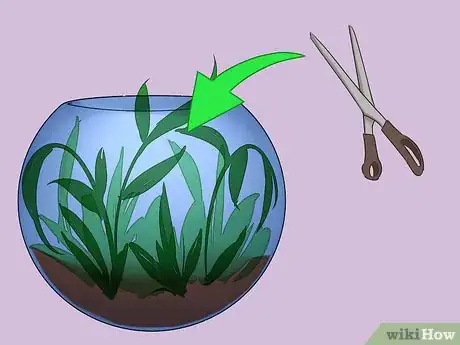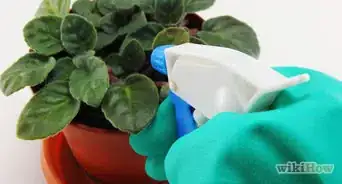This article was co-authored by Bess Ruff, MA. Bess Ruff is a Geography PhD student at Florida State University. She received her MA in Environmental Science and Management from the University of California, Santa Barbara in 2016. She has conducted survey work for marine spatial planning projects in the Caribbean and provided research support as a graduate fellow for the Sustainable Fisheries Group.
There are 10 references cited in this article, which can be found at the bottom of the page.
wikiHow marks an article as reader-approved once it receives enough positive feedback. In this case, several readers have written to tell us that this article was helpful to them, earning it our reader-approved status.
This article has been viewed 252,969 times.
Building a self-sustaining ecosystem is a fun and educational activity. You can build an aquatic ecosystem in a fish tank or you can build a terrarium with any plants you choose. The process is quite simple, but striking the balance between organisms can be tricky. With trial and error, time, and persistence, you can develop your very own self-sustaining ecosystem.
Steps
Building an Aquatic Ecosystem
-
1Choose a size for your ecosystem. If you are new to building ecosystems, you may want to start small. However, the smaller your container, the harder it is to maintain a self-sustaining environment. Larger containers allow for the inclusion of multiple diverse species and give everything room to grow. All containers must be clear to let in light.
- A small glass bowl is fast to set up and doesn’t take up much space. While smaller bowls can be more difficult to sustain, they are still manageable for beginners.
- Medium aquariums (10–30 gallons (38–114 l)) have more space for growth, but are more expensive and still limited in the size for growth.
- Large aquarium (60–200 gallons (230–760 l)) have ample space for growth and diversity and are most likely to be successful; however, they are very expensive and hard to make room for.
-
2Expose the tank to fluorescent lighting. Fluorescent lighting is important for the growth of the plants in your ecosystem. It is recommended to provide 2 to 5 watts per 1 gallon (3.8 l) of water for a freshwater aquarium.[1]
- Incandescent lighting will not help your plants grow.
Advertisement -
3Establish the substrate for the ecosystem. The substrate is the soil of the aquarium that allows the plants to anchor and grow. It must be properly established before doing anything else to foster an environment of growth and recycling of nutrients.
- If using a small bowl, start with 1 inch (2.5 cm) of sand and then add about 1⁄2 inch (1.3 cm) of pea gravel on top.
- For medium to larger aquariums, start with 2 inches (5.1 cm) of sand and about 1 inch (2.5 cm) of pea gravel on top.
- Sand and pea gravel can be purchased from a pet store or obtained from a nearby pond.
-
4Fill the container with water. The water is important because it will establish the first source of food for the fish and other organisms: algae and microorganisms. You can start with distilled/bottled water, dechlorinated tap water, or water from a previous fish tank or aquarium.
- If you use distilled/bottled water or dechlorinated tap water, mix some fish flakes in with the water to encourage growth.
- Adding some water from an already established tank will also help growth because it will already have the essential nutrients.
-
5Purchase a variety of plants. When choosing plants you want to consider: how fast they grow (how often you’ll have to trim them), the size of the plant, whether they’re edible for fish and snails, and where in the aquarium they will grow (from the bottom, from the surface, from branches). To cultivate a diverse environment, include some of the following:
- Bottom growth: hair grass, corkscrew grass, or green rotala
- Surface Growth: duckweed, lotus
- Branches: crystalwort, java moss, Christmas moss, phoenix moss
- You want to make sure the plants are well-established (let them grow and become rooted) before adding fish or snails to the ecosystem.
-
6Cultivate micro-critters. The next step in the food chain of your ecosystem is to add micro-critters such as small pond snails, daphnia, and micro-planarians. These will serve as food for all of the fish that don’t eat plants or algae. Aged aquarium media is a good way to seed your tank. This can be purchased at the fish or pet store.[2]
- Most of these organisms can’t be seen by the naked eye, but you should wait at least 2 weeks for them to get fully established before adding fish.
-
7Add fish or shrimp to the system. Once the plants and microorganisms have been established you can start to introduce larger fish into the tank. You want to start with smaller organisms like a guppy, Endler’s livebearer, or cherry shrimp and only add 1 or 2 at a time. These fish also reproduce quickly and serve as a great diet for larger fish.
- If you have a larger aquarium, you can add more and varied fish. Balancing your fish is tricky and takes time. Make sure each species has time to adjust before adding more into the mix.
Maintaining an Aquatic Ecosystem
-
1Change the water. Aquariums take a bit of maintenance to make sure all of your critters stay alive and well. About every 2 weeks, 10-15% of the water in the tank should be replaced with fresh water. If you are using tap water, let the water sit in an aerated bucket for about 24 hours to allow the chlorine to air out.[3]
- Check your local water source to determine if there are heavy metals in your water.
- Use filtered water if you are concerned about the quality of your tap water.
-
2Control algae growth. A gravel vacuum is a handy tool to have to help control the algae in your aquarium. When you change out the water, vacuum the gravel at the same time to remove algae growth and any uneaten food that may have accumulated.[4]
- Clean the aquarium walls with filter floss or a magnetic tank scrubber to keep algae from accumulating on the glass.
- Add plants, snails, or daphnia to help control the growth.
-
3Remove dead fish promptly. Count your fish at least once a week to determine if any have died. Smaller fish can decompose quickly and cause spikes in nitrite, ammonia, and nitrate levels. These can be harmful to the other fish in your tank. If you see a dead fish, remove it as soon as possible.[5]
- Use a test kit to check the levels of ammonia, nitrite, nitrate, and pH. Replace the water if the levels are too high.
- The ideal levels vary depending on the type of fish you have, but in general, the ammonia should be between 0.0 to 0.25 mg/L, the nitrite should be less than 0.5 mg/L, the nitrate level should be less than 40 mg/L, and the pH should stay around 6.[6]
Building a Terrarium Ecosystem
-
1Obtain a sealable, large glass jar. Any sized jar or bottle will be sufficient for your terrarium. A container with a large mouth will make it easier to work inside of. You want to make sure that the container can be properly sealed.[7]
- Options include: a candy jar with a heavy lid, a pasta jar, or a mason jar.
- Make sure the container is properly washed to remove any residue before using as a terrarium.
-
2Fill the bottom with pebbles. The layer of pebbles at the bottom of the jar is to allow water to collect at the bottom and protect the plants from flooding. Add pebbles to a depth of about 1⁄2–2 inches (1.3–5.1 cm).[8]
- It doesn’t matter what type of rock or pebbles you use. You can even use colorful pebbles from the pet store to make it more exciting.
-
3Cover the pebbles with a layer of activated charcoal. The charcoal layer is important to filter out impurities in the water. It helps keep the ecosystem clean and healthy by reducing the burden of bacteria and fungi. You don’t need a thick layer, just enough to cover the rock layer.[9]
- Activated charcoal can be purchased at a local pet store.
-
4Add a 1⁄2 inch (1.3 cm) layer of peat moss. On top of the charcoal layer, you will add another layer of peat moss. Peat moss is a nutrient-rich soil that will help hold the water and nutrients necessary for the plants to grow.[10]
- Peat moss can be obtained a local nursery.
-
5Layer potting soil on top of the peat moss. The final layer before adding the plants is a layer of potting soil. The plants will be able to root in this soil and get the water and nutrients they need from the combination of all of the layers below the potting soil.[11]
- Add enough soil for the plants to take root and have room for growth. A depth slightly higher than the pot the plant came in should be good.
- Most types of potting soil will be sufficient for this. Succulents and cacti require a special type of soil.
-
6Add small plants. Any plant you’d like to add will work in your terrarium, but small plants are recommended. Prepare your plants by removing them from their pots and breaking up the hard soil around their roots. Trim particularly long roots before planting. Dig a small well in the soil with a spoon and place the roots of the plant into the hole. Add a bit of soil on top and pack it down around the plant.[12]
- Repeat this process with the rest of your chosen plants taking care to keep the plants away from the edges of the container.
- Try to avoid having the leaves touching the sides of the container as much as possible.
- Some great plants to start with include moon valley friendship, the nerve plant, variegata, aquamarine, minimus aureus, strawberry begonias, ferns, and mosses.[13]
-
7Seal the terrarium and place it in indirect sunlight. Put the lid or cork in place once you’ve added your plants. The terrarium will do well in an area with bright but indirect sunlight. The terrarium will dry out if you place it in an area with lots of direct light, but the plants won’t thrive if the terrarium is always shaded. Opt for an area near a window.[14]
Maintaining a Terrarium Ecosystem
-
1Water the plants only if necessary. With a sealed system, the terrarium shouldn’t need much maintenance. If you notice it is looking a bit dry, open it up and add a bit of water. Alternatively, if there is a lot of moisture inside, leave the lid off for a day or 2 to let it dry out for a bit.[15]
-
2Remove bugs if you see any. There might have been bug eggs in the soil or on your plants. If you notice anything crawling around inside, let it out and then reseal your ecosystem.[16]
-
3Prune the plants as needed. With proper sunlight and water, your plants will grow. If the plants get too big for the terrarium, you need to cut them back so it doesn’t get overcrowded. Keep the plants at your desired size so that they continue to thrive.[17]
- Remove any dead plants that may have fallen to the bottom.
-
4Clear out algae and fungus regularly. If algae or fungus grows on the sides of the glass, you can easily clean it off. Use a piece of soft cloth or a cotton ball to wipe it away so you can clearly see through the glass.
Community Q&A
-
QuestionCan I put in some insects? Like ladybugs or ants?
 Kicky RickyCommunity AnswerYes, you can put in ladybugs, just make sure they have food (they eat plant louse). Ants are not solitary insects, they cannot live without their colony and the queen.
Kicky RickyCommunity AnswerYes, you can put in ladybugs, just make sure they have food (they eat plant louse). Ants are not solitary insects, they cannot live without their colony and the queen. -
QuestionCan I put water into ecosystems like a fish tank?
 Community AnswerSure, as long as the water has enough nutrients for the living things inside the fish tank.
Community AnswerSure, as long as the water has enough nutrients for the living things inside the fish tank. -
QuestionCan coriander seeds be planted in this terrarium?
 Community AnswerAny plant can be planted, just as long as it doesn't get too big and has proper sun and care.
Community AnswerAny plant can be planted, just as long as it doesn't get too big and has proper sun and care.
References
- ↑ http://davesgarden.com/guides/articles/view/1163/
- ↑ http://davesgarden.com/guides/articles/view/1163/
- ↑ http://www.algone.com/aquarium-maintenance-tips-and-fish-care-guidelines
- ↑ http://www.petco.com/content/petco/PetcoStore/en_US/pet-services/resource-center/home-habitat/Maintaining-Your-New-Aquarium.html
- ↑ http://www.practicalfishkeeping.co.uk/features/articles/what-to-do-if-you-find-a-dead-fish-in-your-tank
- ↑ https://www.petsmart.com/learning-center/fish-care/healthy-aquarium-water/A0083.html with https://www2.gov.bc.ca/assets/gov/environment/air-land-water/water/waterquality/water-quality-guidelines/approved-wqgs/bc_env_nitrate_waterqualityguideline_overview.pdf
- ↑ https://vivariumtips.com/can-a-terrarium-be-sealed
- ↑ http://inhabitat.com/diy-how-to-make-your-own-green-terrarium-to-keep-or-give-away-for-the-holidays/
- ↑ http://inhabitat.com/diy-how-to-make-your-own-green-terrarium-to-keep-or-give-away-for-the-holidays/
- ↑ http://reekoscience.com/science-experiments/miscellaneous/how-to-create-terrarium-vivarium-self-sustainable-bottle-garden
- ↑ http://inhabitat.com/diy-how-to-make-your-own-green-terrarium-to-keep-or-give-away-for-the-holidays/
- ↑ http://inhabitat.com/diy-how-to-make-your-own-green-terrarium-to-keep-or-give-away-for-the-holidays/
- ↑ http://www.bhg.com/gardening/houseplants/projects/top-plants-for-terrariums/
- ↑ http://reekoscience.com/science-experiments/miscellaneous/how-to-create-terrarium-vivarium-self-sustainable-bottle-garden
- ↑ http://reekoscience.com/science-experiments/miscellaneous/how-to-create-terrarium-vivarium-self-sustainable-bottle-garden
- ↑ http://reekoscience.com/science-experiments/miscellaneous/how-to-create-terrarium-vivarium-self-sustainable-bottle-garden
- ↑ http://www.hortmag.com/weekly-tips/cultivation/how-to-take-care-of-a-terrarium
About This Article
To build a self-sustaining ecosystem, start by lining the bottom of a large, sealable glass jar with pebbles, followed by a layer of activated charcoal to keep the ecosystem free of bacteria and fungi. Next, add peat moss and potting soil, then add your plants, making sure to choose something small like ferns or begonias. Additionally, try to keep your plants from touching the sides of the container to ensure they have plenty of breathing space. Then, place the lid on your jar and put it near a window, or another area with bright but indirect sunlight. To learn more, like how to create an aquatic self-sustaining ecosystem with snails and fish, read on!



